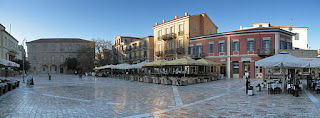Dixie-Confederate states Greeks
Intro
1528: Don Theodoro,officially the First Greek to have been to what is today USA, lands in Florida.
1592: Greek Captain Juan de Fuca sailed up the Pacific coast under the Spanish flag, in search of the fabled Northwest Passage between the Pacific and the Atlantic. He reported discovering a body of water, a strait which today bears his name: the Strait of Juan de Fuca, which today forms part of the Canada–United States border.
1768: 500 Greeks create the first Greek colony in USA, particularly in Florida.
1850's: The first significant Greek community to develop in USA, in New Orleans, Louisiana
*Before 1890, the vast majority of Greeks, either during the first colonial wave or later as immigrants prefer the Southern states
Greeks in the American civil war
In 1861, the Greeks living in New Orleans organized their own volunteer militia regiment to fight on the Confederate side in the Civil War.
a note from the May 28, 1861 issue of the Daily True Delta, an old New Orleans newspaper:
"Our Greek fellow citizens are emulating the public spirit of other nationalities, and are organizing a company. The old blood which animated the heart of heroic Greece will be found yet strong in the veins of her children resident among us"
Officers cited Greece as their birthplace, in 10th Louisiana Infantry Regiment:
-- Paoli Agius, age 35, a sailor
-- Francisco Liappi, age 48, a sailor
-- John George Metalieno, age 30, a sailor
-- Andre Nicole, age 33, a sailor
-- Christopholo Salonicho, age 40, a sailor
-- Constantino Villisariez, age 22, a sailor
*there were many others who cited the states as their birthplace
"Order No. 478
Col. J. T. Winnemore will issue to Capt. Nicolas Touloubief of the Greek Company A of one captain, three lieutenants, eight noncommissioned officers and seventy privates . . .(illegible) . . and subsistence stores . . .(illegible). . ."
Col. J. T. Winnemore will issue to Capt. Nicolas Touloubief of the Greek Company A of one captain, three lieutenants, eight noncommissioned officers and seventy privates . . .(illegible) . . and subsistence stores . . .(illegible). . ."
The soldiers who fought for the Confederacy did not come from diverse ethnic backgrounds. The majority of them had ancestors from Scotland, England, Wales, and Ireland; many others, however, could point to roots in France, Southern Europe, and North America itself. The Hispanic soldiers of such regiments as the 33rd Texas Cavalry, C.S., also served, and could count forebears farther back than their Eastern brothers, who boasted ancestors that had founded their states or commonwealths...
... The Union forces were a more disparate lot. Because the North was not ringed about by a blockade, immigration continued unabated, and was in fact enhanced, by the war; some of the newcomers, grateful to be in the land of the free, joined up within months of their arrival in hopes of somehow becoming more worthy of their new land. But the forces that marched off at the beginning of the war to subdue the secessionists were made up of just as many old Revolutionary families as the South could boast; descendants of Paul Revere, of Ethan Allen, and of other colonial Americans were among them. Whole regiments from the privileged families of the East Coast marched off to war; their commanding officers were very often their professors from the university, a fact of life in the South, as well. German immigrants from Pennsylvania and western New York; Swedes and Norwegians from the upper Midwest; Irish and Italians from Boston, Philadelphia, and New York; and the North, too, had its Texan contingents, such as the Second Texas Cavalry (union)....
... The Union forces were a more disparate lot. Because the North was not ringed about by a blockade, immigration continued unabated, and was in fact enhanced, by the war; some of the newcomers, grateful to be in the land of the free, joined up within months of their arrival in hopes of somehow becoming more worthy of their new land. But the forces that marched off at the beginning of the war to subdue the secessionists were made up of just as many old Revolutionary families as the South could boast; descendants of Paul Revere, of Ethan Allen, and of other colonial Americans were among them. Whole regiments from the privileged families of the East Coast marched off to war; their commanding officers were very often their professors from the university, a fact of life in the South, as well. German immigrants from Pennsylvania and western New York; Swedes and Norwegians from the upper Midwest; Irish and Italians from Boston, Philadelphia, and New York; and the North, too, had its Texan contingents, such as the Second Texas Cavalry (union)....





Σχόλια
Δημοσίευση σχολίου